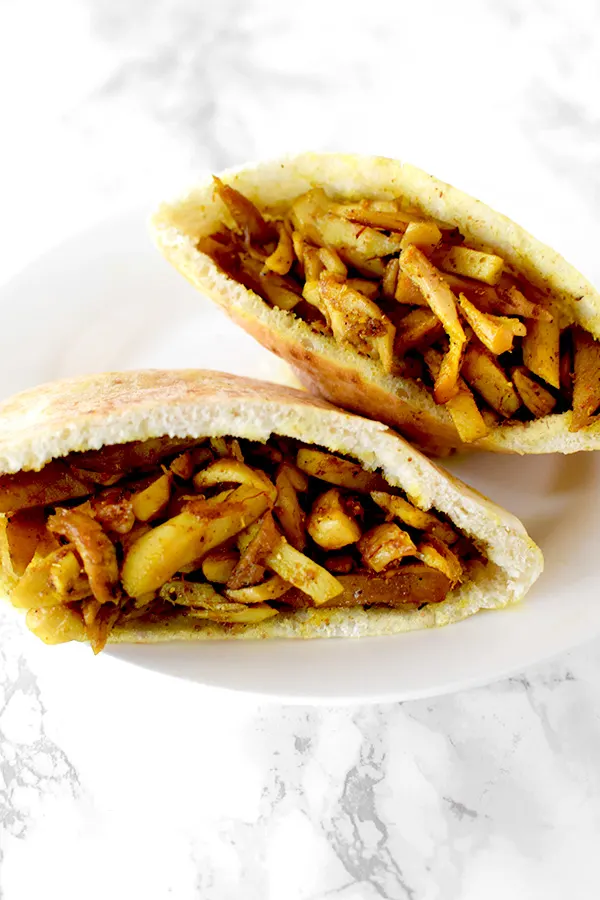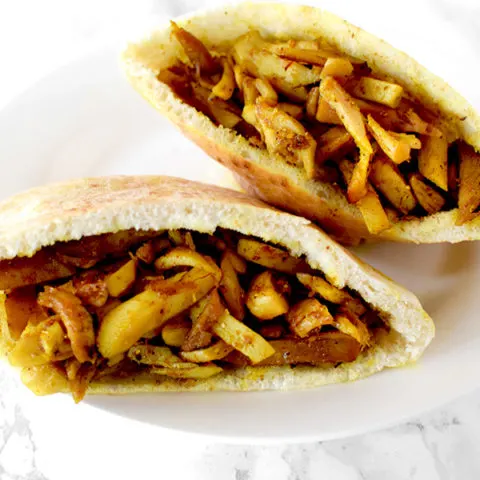Shawarma is one of the most beloved street foods in Israel - especially among tourists! It isn't hard to make at home though, so you can easily bring the flavors of Israel to your kitchen.

Shwarma originated in the Ottoman Empire and is today popular across the Middle East and is closely related to the Greek Gyro.
Traditionally, shawarma was made with lamb but can also be made with goat, beef, turkey, or chicken.
In Israel, all of these versions can be found (I've tried all of them), but turkey is the most popular, followed by lamb and chicken.
In fact, turkey shawarma is eaten so much in Israel, that Israelis eat more turkey than anyone else globally. Due to Thanksgiving, Americans are in second place.
In fact, since shawarma is typically made with boneless skinless turkey thigh, raw pieces are actually labeled "shawarma" in supermarkets.
Still, the lamb flavor is ideal, so you'll often see slices of lamb fat at the top of rotisserie. As the fat melts, it drips down, adding flavor and preventing the meat from drying out.
Shawarma is sliced off the skewer as orders are placed. It is then served along in a pita or a lafa that has been shmeered with chumus (hummus), along with french fries and Israeli salad, and drizzle with techina (tahini).
I'm a purist, so I leave it there, but people add all kinds of pickled vegetables and/or top with amba.
For those who like it spicy, "charif" (which means spicy and is actually called "schoog") is added for an extra kick.
IS KOSHER CHICKEN BETTER?
Kosher animals are kept in better conditions than non-kosher animals due to strict kosher health requirements of the animals.
Also, the salting process used as part of the process of making meat kosher is similar to dry brining, and therefore produces a better quality meat.
While I’ve only eaten kosher meat so I cannot compare, I’ve been told by non-Jews who do not keep kosher that they’ve noticed that kosher chicken is of superior quality to cook with.
SHOULD YOU WASH CHICKEN?
According to the USDA, you should not wash meat or poultry, since water can splash bacteria up to 3 feet surrounding your sink.
A study done by Drexel University shows that it is best to move meat and poultry directly from package to pan. The heat from cooking will get rid of any bacteria that may be present.
HOW CAN I CLEAN MY CHICKEN WITHOUT WASHING IT?
If you want to clean your chicken without washing it, wipe it down with a wet paper towel.
Just make sure the paper towel doesn't touch anything else and to toss the paper towel right away.
HOW TO DEFROST CHICKEN
IN THE FRIDGE
Defrosting chicken in the fridge is the most highly recommended.
To do this, place the frozen chicken in a pan and let it thaw. Oftentimes, when chicken thaws, it releases liquids that can leak onto your fridge, so the pan is really helpful.
Chicken typically takes a full day to thaw. Once thawed, it can remain in the refrigerator for a day or two before cooking.
IN COLD WATER
Defrosting chicken in water should take two to three hours.
Submerge your sealed chicken in a pot or bowl full of cold water. Change out the water every 30 minutes or so.
Do not hot use water because it can start cooking your chicken.
Can you cook FROZEN chicken?
According to the USDA, you can cook frozen chicken. It will take 50% longer to cook, but it’s an option.
You should also cook it on a roasting rack or over vegetables so that the heat can circulate around the chicken.
CAN YOU REFREEZE RAW CHICKEN?
According to the USDA, “food thawed in the refrigerator is safe to refreeze without cooking.” However, you do lose quality when refreezing previously defrosted meat.
Every time you defrost meat, it loses moisture as it thaws, which also leads to a loss in flavor. To compensate for this, marinate the chicken to add more flavor and juice.
The USDA also says not to “refreeze any foods left outside the refrigerator longer than 2 hours; 1 hour in temperatures above 90°F.”
SHOULD YOU BRINE?
Brining actually doesn’t do anything to help poultry. In fact, it makes it soggy rather than juicy, with watered-down flavor.
Aromatic brines and stock don’t help with flavor either. This is because the salt pulls water molecules in, leaving most of the flavor behind.
DRY BRINING
A dry brine, on the other hand, loosens up muscle fibers, allowing them to retain more moisture without adding any excess liquid.
Initially, the salt draws moisture out, then it dissolves in this liquid, creating a concentrated brine, which eventually gets reabsorbed. This leads to more intensely flavored results.
An added benefit is that it also requires less space and mess than a water brine. Not to mention the fact that it allows for crispier skin.
CAN YOU DRY BRINE KOSHER chicken?
Food experts are often under the impression that kosher meat and poultry cannot be brined and dry brined.
This is because of the koshering process, which involves salting the meat. However, the process is not nearly as long as the dry brining process, and unlike a dry brine, the poultry is soaked to remove the salt.
So, since the process is different than a dry brine, it is fine and even recommended to dry brine kosher poultry and meat.
How do you dry brine chicken?
Begin by patting the chicken with paper towels. This will help the salt adhere to the chicken.
Grab pinches of kosher salt and sprinkle it over the chicken until the chicken is generously salted and evenly coated.
Place the dry-brined chicken on a rack or a plate and refrigerate it. Refrigerate chicken pieces for at least 1 hour, skinless pieces for 30 minutes to 1 hour or up to about 12 hours, and a whole chicken for 8-24 hours.
Once the waiting period is up, there is no need to rinse off the chicken. Just cook it as usual.
HOW TO STORE CHICKEN
Place cooled chicken in an airtight container or wrap in heavy-duty aluminum foil or plastic wrap. Store in the fridge for up to 4 days.
HOW TO FREEZE CHICKEN
Freeze leftovers within 3-4 days. Place cooled chicken in an airtight container or resealable freezer bag.
Freeze for up to 4-6 months. After that, it is still safe to eat, but the quality begins to degrade.
Israeli Shawarma

Shawarma is one of the most beloved street foods in Israel. It is easy to make at home, so you can make it in your own kitchen.
Ingredients
- 2 pounds boneless skinless turkey or chicken thigh*
- 2 tablespoons olive oil
- 2 tablespoons shawarma spice
- ½ cup olive oil or schmaltz
- 2 ounces lamb fat, optional
Instructions
- Place chicken or turkey thigh into a bowl along with olive oil and shawarma spice.
- Mix to combine until pieces are well coated.
- Heat 3 tablespoons of olive oil in a pan. If using lamb fat, fry it for 2 to 3 minutes.
- Add chicken thigh or managable pieces of turkey thigh.
- Cook on a medium heat for 5 to 7 minutes. Turn over and cook for another 5 to 7 minutes.
- Remove and let meat rest for five minutes.
- Slice into about ¼-inch pieces. Then, cut to make sure that no pieces are longer than 1 inch.
- Serve in a pita lined with chumus (hummus), top with french fries and Israeli salad, and drizzle with techina (tahini).
Notes
If using turkey thigh, cut and pound into managable pieces.
Nutrition Information:
Yield:
8Serving Size:
1Amount Per Serving: Calories: 423Total Fat: 29gSaturated Fat: 6gTrans Fat: 0gUnsaturated Fat: 22gCholesterol: 152mgSodium: 153mgCarbohydrates: 0gFiber: 0gSugar: 0gProtein: 38g